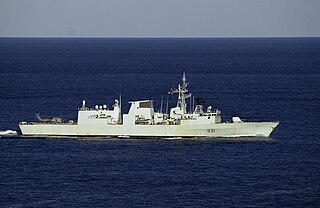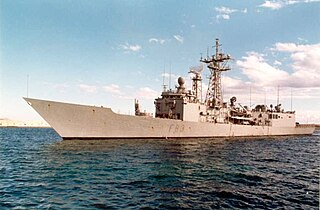
The Santa María class of guided missile frigates is the Spanish Navy's designation for six warships based on the United States Oliver Hazard Perry-class frigates. Spanish ships have a slightly bigger beam and were built with a greater weight reserve for future improvements. Other changes from the basic model include Meroka replacing Phalanx and a RAN-12L air search radar to provide low horizon coverage against sea skimmers cueing the Meroka CIWS mount. The Nettunel EW suite replaced the SLQ-32 system fitted aboard US ships. The first ship Santa Maria entered service in 1986.

HMCS Toronto is a Halifax-class frigate that has served in the Canadian Forces since 1993. Toronto is the fourth ship in her class which is the name for the Canadian Patrol Frigate Project. She is the second RCN ship to be named for Canada's largest city. When not on operations she is assigned to Maritime Forces Atlantic (MARLANT) and is based at CFB Halifax. Toronto serves on MARLANT missions protecting Canada's sovereignty in the Atlantic Ocean and enforcing Canadian laws in its territorial sea and exclusive economic zone.

The Halifax-class frigate, also referred to as the City class, is a class of multi-role patrol frigates that have served the Royal Canadian Navy since 1992. The class is the outcome of the Canadian Patrol Frigate Project, which dates to the mid-1970s. HMCS Halifax was the first of an eventual twelve Canadian-designed and Canadian-built vessels which combine traditional anti-submarine capabilities with systems to deal with surface and air threats as well. Ships of the class are named after capital cities of Canadian provinces, the capital of Canada, Ottawa, and the major cities of Calgary, Montreal, and Vancouver.

HMCS Halifax is a Halifax-class frigate that has served in the Royal Canadian Navy and Canadian Forces since 1992. Halifax is the lead ship in her class which is the name for the Canadian Patrol Frigate Project. She is the second vessel to carry the designation HMCS Halifax. She carries the hull classification symbol FFH 330.

HMCS Vancouver is a Halifax-class frigate, of the Royal Canadian Navy launched on 8 July 1989, as the second vessel of her class. She is based at CFB Esquimalt on the west coast of Canada, and is the third vessel to be named after Vancouver, British Columbia.

ROCS Yueh Fei, is a Cheng Kung-class guided-missile frigate of the Republic of China Navy (ROCN). She is the fourth ship of the class. Named for the famous Chinese commander Yue Fei, the ship was constructed by the China Shipbuilding Corporation at their yard in Kaoshuing, Taiwan. The Cheng Kung-class frigates are based on the American Oliver Hazard Perry class and share many of the same characteristics, the main difference being armed with Taiwanese Hsiung Feng II and Hsiung Feng III surface-to-surface missiles and different sensors. Yueh Fei was laid down on 5 September 1992, launched on 26 August 1994 and commissioned into the ROCN on 7 February 1996.

Santa María (F81) is the lead ship of six Spanish-built Santa Maria-class frigates of the Spanish Navy, based on the American Oliver Hazard Perry class design. The vessel was constructed in 1982 and was launched on 11 November 1984. Santa María was commissioned on 12 October 1986. The frigate has served in NATO maritime operations.

Reina Sofía (F84) is the fourth of six Spanish-built Santa María-class frigates of the Spanish Navy. The Santa María class is based on the American Oliver Hazard Perry-class design, providing an anti-air warfare platform with anti-submarine and anti-surface warfare capabilities at a reduced cost. Reina Sofía was constructed by Bazan and was laid down on 12 October 1987 and launched on 19 July 1989. The ship was commissioned in 1990 and has seen service in the Mediterranean Sea and off Somalia.

Numancia (F83) is the third of the six Spanish-built Santa Maria-class frigates of the Spanish Navy, based on the American Oliver Hazard Perry class design. The frigate was constructed in Spain by Bazan and laid down on 8 January 1986; launched on 29 January 1987; and entered service with the Spanish Navy on 17 November 1989. Based at Rota, Numancia has been deployed to the Indian Ocean to fight piracy in Somalia as part of Operation Atalanta and to the Mediterranean Sea to intercept illegal trafficking of migrants as part of Operation Sophia.

Canarias (F86), is the last of the six Spanish-built Santa María-class frigates of the Spanish Navy, which are based on the American Oliver Hazard Perry-class design. The Santa María class offer both anti-air and anti-submarine defence for the Spanish Navy. The frigate was laid down by Bazan on 15 April 1992 and launched on 21 June 1993. Upon entering service on 14 December 1994, Canarias was homeported at Rota and assigned to the 41st Escort Squadron. Canarias has been assigned to Operation Atalanta of the Somali coast, combatting piracy and Operation Sophia in the Mediterranean Sea, intercepting illegal trafficking of migrants.

Navarra (F85) is the fifth of the six Spanish-built Santa Maria-class frigates of the Spanish Navy, which are based on the American Oliver Hazard Perry-class design. The vessel was constructed by Bazan and launched on 23 October 1992 and commissioned on 27 May 1994. The Santa Maria-class frigates provide anti-submarine and anti-air defence for the Spanish Navy.

Victoria (F82) is the second of the six Spanish-built Santa Maria-class frigates of the Spanish Navy, based on the American Oliver Hazard Perry class design. Constructed in 1983, the vessel was launched on 23 July 1986 and commissioned on 11 November 1987. The frigate has been assigned to Operation Atalanta, fighting piracy of the Somalian coast.

HMCS Calgary is a Halifax-class frigate that has served in the Canadian Forces and Royal Canadian Navy since 1995. Calgary is the sixth vessel in her class and the second vessel to carry the name Calgary. She was built as part of the Canadian Patrol Frigate Project. Calgary began the FELEX refit in June 2012. She is assigned to Maritime Forces Pacific (MARPAC) and is homeported at CFB Esquimalt. Calgary serves on MARPAC missions protecting Canada's sovereignty in the Pacific Ocean and enforcing Canadian laws in its territorial sea and exclusive economic zone.

HMCS Ottawa is a Royal Canadian Navy Halifax-class frigate. Ottawa is the twelfth and final ship of the Halifax class that were built as part of the Canadian Patrol Frigate Project. She is the fourth vessel to carry the name HMCS Ottawa. The first three were named for the Ottawa River. This ship is the first named for Canada's national capital, the City of Ottawa. She is assigned to Maritime Forces Pacific (MARPAC) and is homeported at HMC Dockyard, CFB Esquimalt. Ottawa serves on MARPAC missions protecting Canada's sovereignty in the Pacific Ocean and enforcing Canadian laws in its territorial sea and Exclusive Economic Zone. Ottawa has also been deployed on missions throughout the Pacific and to the Indian Ocean; specifically the Persian Gulf and Arabian Sea on anti-terrorism operations.

HMCS Regina is a Halifax-class frigate that has served in the Canadian Forces and Royal Canadian Navy since 1993. Regina is the fifth vessel in her class which is the name for the Canadian Patrol Frigate Project. She is the second vessel to carry the designation HMCS Regina. She is assigned to Maritime Forces Pacific (MARPAC) and is homeported at CFB Esquimalt.

HMCS Ville de Québec is a Halifax-class frigate that has served in the Canadian Forces and Royal Canadian Navy since 1993. Ville de Québec is the third vessel in her class which is the name for the Canadian Patrol Frigate Project. The frigate is the second Royal Canadian Navy ship to be named Ville de Québec and is Canada's only fully bilingual warship. She is assigned to Maritime Forces Atlantic (MARLANT) and is homeported at CFB Halifax. The vessel serves on MARLANT missions protecting Canada's sovereignty in the Atlantic Ocean and enforcing Canadian laws in its territorial sea and exclusive economic zone.

ROCS Tian Dan is the eighth ship of the Cheng Kung-class guided-missile frigates of the Republic of China Navy (ROCN), which was based on the Oliver Hazard Perry class of the United States Navy. Tian Dan was intended to be the first hull of the second batch of the class, with improved armament and electronics. However, delays in the development of the weapon systems and electronics led to the second batch being cancelled. In 1999, the first ship of the second batch was re-ordered to the standard design with all the improvements to the design. The ship was constructed beginning in 2001 by the China Shipbuilding Corporation in Taiwan and the frigate was launched in 2002 and entered service with the ROCN in 2004. In 2014, Tian Dan was among the Taiwanese vessels sent to assist in the search for the missing Malaysia Airlines MH370 flight.

The Cheng Kung-class frigates are eight guided-missile frigates in service in the Republic of China Navy (ROCN). They are based upon the U.S. Oliver Hazard Perry class and built by China Shipbuilding Corporation in Kaohsiung, Taiwan under license throughout the 1990s as part of the Kuang Hua I project. These frigates served as the mainstay of the ROCN's area air defense capability prior to the acquisition of the Keelung (Kidd)-class destroyers in 2005. They are designated with the hull classification PFG rather than FFG used by the Oliver Hazard Perry class.

The João Belo class, also known as Comandante João Belo class, is a class of four frigates of French design, based on the Commandant Rivière class but fitted for tropical service. Ordered by the Portuguese Navy in 1964, the four ships of this class were constructed at the shipyard in Nantes, France between 1965 and 1967. The first ship entered Portuguese service in 1967. The frigates were used for ocean patrol of Portuguese colonies and later, joined NATO's STANAVFORLANT unit. The first unit was discarded in 2003, followed by a second in 2004. The final two ships were taken out of service in 2008 sold to the Uruguayan Navy. The third ship was discarded in 2021, and the last ship was decommissioned on 12 August 2022.

The Baleares class were a group of five frigates built for the Spanish Navy in the late 1960s and 1970s. The ships were a modified version of the American Knox-class frigates. The key differences are the replacement of helicopter facilities by a medium-range surface-to-air missile system and associated radars. Constructed between 1968 and 1976, the Baleares class began entering service in 1973 and formed the 31 Escort Squadron, based at Ferrol. The five ships were upgraded several times during their service lives. The ships were retired beginning in the mid-2000s and replaced by the Álvaro de Bazán-class frigates on a one-to-one basis.


















